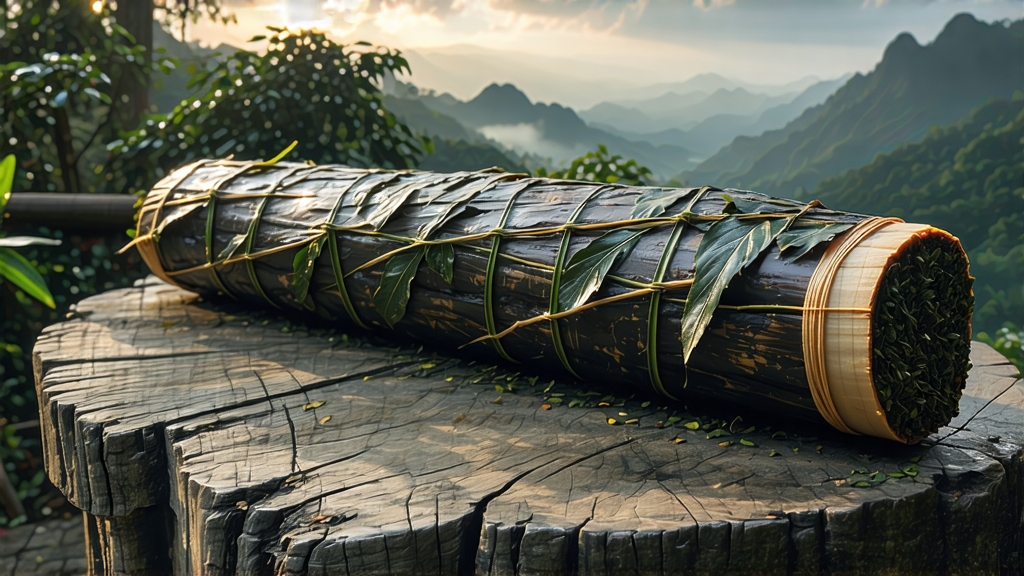
When most international drinkers think of Chinese dark tea, the pressed disks of Yunnan Pu-erh usually steal the spotlight. Yet 1 000 km to the northeast, cradled by the cloud-wrapped Xuefeng and Wuling ranges, Hunan province has been quietly producing its own monumental contribution to the post-fermented tea world: Qianliang Cha, literally “Thousand-Tael Tea.” Far from the palm-sized bing or tuo, a single unit of Qianliang Cha is a formidable log almost 1.6 m long, weighing roughly 36 kg (the old “thousand tael” measurement). To encounter it is to meet tea re-imagined as architecture—an edible pillar designed to be carved, rather than sipped, by the caravan pound.
1. Historical footprint along the tea-horse road
The genesis story begins in the 19th-century market town of Anhua on the Zi River. Local merchants needed a compact, mould-resistant cargo that could survive the 3 000 km journey to the Tibetan plateau and the Central Asian steppe. By compressing already dark-fermented tea into an elongated cylinder sheathed in bamboo and palm bark, they created a self-protecting freight that doubled as currency: segments were sliced off with a machete and bartered for horses, salt, or medicinal herbs. Caravans leaving Anhua climbed westward through Zhangjiajie’s sandstone peaks, the tea logs lashed to mule saddles like giant scrolls. Along the way, swings in humidity, temperature, and the ceaseless jostling of pack animals coaxed an even deeper microbial ripening. By the time the tea reached Lhasa or Kashgar, its flavour had evolved from merely smoky to something approaching liquid mahogany—an edible ledger of every mile it had travelled.
2. Terroir and leaf: why Anhua?
Anhua county sits at the northern edge of China’s subtropical belt, where acidic granite soils meet a riverine microclimate that averages 78 % relative humidity. The indigenous Yun-da-ye cultivar (a large-leaf, late-budding camellia) develops unusually thick cell walls, ideal for hosting the Eurotium cristatum mould that will later create the prized “golden flowers” (golden spores) inside the bamboo jacket. Farmers pluck one bud with four or five leaves in late May, after the spring rains but before the summer heat turns the leaf too coarse.
3. Crafting a thousand-tael pillar
The transformation from fresh leaf to compressible raw material follows five meticulous stages:
a. Withering – 6–8 hours on bamboo racks inside ventilated lofts; leaf loses 15 % moisture and grassy notes.
b. Kill-green – 280 °C wok firing for 3 minutes; enzymes are halted while leaf remains supple enough for rolling.
c. Rolling & Piling – 40 minutes of machine rolling followed by 12 hours of damp-piling at 55 °C, initiating fungal dominance.
d. Sun-fixing – Spread under Hunan’s fierce mountain sun for one full afternoon; moisture drops to 20 %, concentrating sugars.
e. Firing – A gentle 80 °C oven pass to arrest further oxidation; the “mao cha” is now ready for the log press.
The pressing itself is a communal spectacle staged each autumn. In an open courtyard, a 3-metre-deep earth pit is lined with woven palm leaves. Pre-steamed mao cha is poured in, trodden barefoot to expel air pockets, then wrapped around a central bamboo pole. Up to seven men tighten hoops of rattan, compressing the mass into a dense cylinder. Once cooled, the pole is extracted, leaving a hollow core that promotes airflow during the ensuing 28-day “flower-fermentation” inside a steam-heated room. Finally the log is encased in seven concentric sleeves of bamboo bark and bound with exactly 104 rattan strips—an ancient quality-control code: if any strip loosens, the batch is rejected.
4. The science of slow fermentation
Inside the bamboo cocoon, oxygen levels drop to 3 % while humidity hovers at 70 %. Under these micro-aerobic